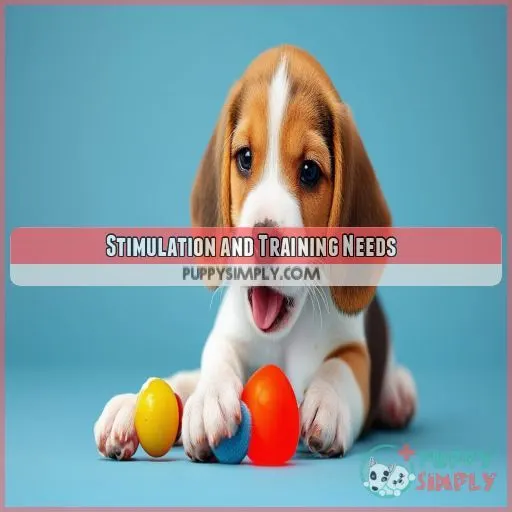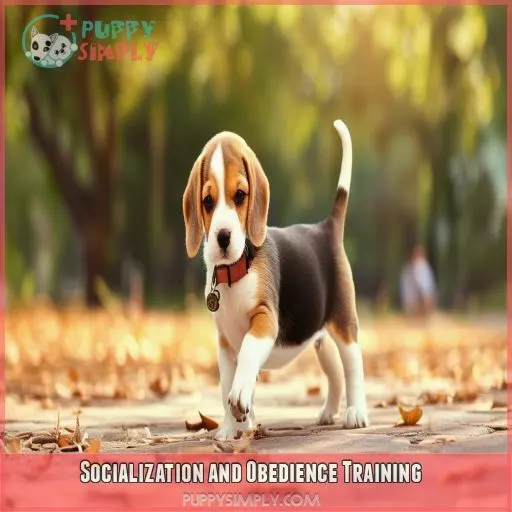This site is supported by our readers. We may earn a commission, at no cost to you, if you purchase through links.

This article intends to give you professional, practical tips on how to get past any problems encountered during training and understand your pet’s needs through positive reinforcement techniques.
All it takes for a new dog or seasoned owner to master Beagle training truly is patience, consistency, and the right approach toward raising a well-behaved companion
Table Of Contents
- Key Takeaways
- Are Beagles Easy to Train?
- Beagle’s Independent Nature
- Challenges in Training Beagles
- Stimulation and Training Needs
- Positive Reinforcement Training
- Socialization and Obedience Training
- Puppy Training Classes
- Patience and Persistence
- Scentwork and Nosework
- Clicker Training
- Rewards-Based Training
- Frequently Asked Questions (FAQs)
- Are beagles the hardest dog to train?
- Are beagles hard to house train?
- Are beagles good for beginners?
- Are beagles high maintenance?
- How long does it take to train a beagle?
- Can a beagle be trained?
- Are Beagles hard to train?
- Are Beagles receptive to training?
- How often should I bathe my Beagle?
- What health issues are Beagles prone to?
- How do I groom a Beagle’s coat?
- How can I prevent a Beagles weight gain?
- What care does a Beagles ears require?
- Conclusion
Key Takeaways
- Beagles are like that friend who always follows their nose – their strong scent drive and independent streak can make training a bit of an uphill battle. But don’t throw in the towel just yet!
- positive reinforcement is your secret weapon. Treats, praise, and patience will get you further than trying to out-stubborn a Beagle. It’s like trying to herd cats – frustrating, but not impossible with the right approach.
- Consistency is key, folks. You’ll need to stick to your guns and keep at it day after day. Rome wasn’t built in a day, and neither is a well-trained Beagle. But trust me, the payoff is worth it!
- Get creative with scent work and nose games. It’s like letting a kid loose in a candy store – they’ll be having so much fun, they won’t even realize they’re learning. Plus, it’s a great way to tire out those energetic little furballs!
Are Beagles Easy to Train?
Are beagles easy to train? Not exactly. These charming hounds come with a stubborn streak that can challenge even experienced dog owners. Their independent nature and strong hunting instincts mean they’re often more interested in following their noses than your commands.
However, don’t let that deter you! With patience, consistency, and positive reinforcement, you can successfully train your Beagle. Focus on early socialization, plenty of mental and physical stimulation, and reward-based techniques
Beagle’s Independent Nature
Beagles are independent, which may be a bit far from the truth, primarily because they need to be strongly hunting-minded. In training a Beagle, you have to deal with a breed that goes after what his nose tells him, many times leading to selective hearing.
Scents drive them, and when they pick up something interesting, their roaming behavior kicks in. This dedication toward tracking has made them good at sniffing out an easy way out. You’ll notice that your Beagle often becomes very engrossed in sniffing around and is entirely unwilling to heed commands.
It’s essential to understand this; their independence isn’t stubbornness but a part of what the breed is. Always channel this determined nature into training sessions with patience and consistent reinforcement
Challenges in Training Beagles
Training a Beagle isn’t a piece of cake. The brains behind the stubbornness and selective hearing in Beagles lie in their strong hunting instincts. Beagles are born to follow scents that may lead them, which may sometimes make them ignore the commands while following such scents. It’s their independent nature that’s responsible for making them a little more challenging to train than other breeds of dogs.
Proper Beagle training calls for patience, consistency, and creativity. Provide mental stimulation; satisfy exercise needs. Crate training will help in controlling their behavior and keeping them safe. Understand that there needs to be a balance.
It can be challenging to overcome the natural tendencies of a Beagle, but by knowing these difficulties, one can understand how to train them properly
Stimulation and Training Needs
Having understood what challenges you might encounter while training a Beagle, stimulation, and training needs must be met. Beagles require adequate exercise and mental stimulation. An enclosed yard will provide freedom to your Beagle, but regular walks should also form part of the routine.
They can be pretty selective when it comes to their hearing, so you’ll need to consistently work on basic obedience skills and set down clear boundaries. Playing and having a backyard are beautiful outlets for all the energy. Positive experiences, like praise, boost their self-confidence. And always remember: a physically and mentally full Beagle is much happier and more accessible to go along with, hence avoiding destructive behaviors like barking/holing excessively.
Positive Reinforcement Training
Positive reinforcement is the key to successful Beagle training. Reward desired behavior with treats and motivation.
Although repetition will build habits, it also aids in bonding and trust between you and your Beagle through consistency. Play and interact during training; it doesn’t have only to be a repetition of commands, but it’s a way to connect.
Patience and understanding are required because Beagles can be pretty stubborn. Good behavior should be rewarded quickly, and punishment shouldn’t be used at all.
Practical beagle training also includes education on commands, recall, and potty training. If problems occur during the process, it may be noteworthy to consult a professional trainer.
Remember that positive reinforcement will make your pet cooperative and happy, thereby making training more accessible and more fruitful in the end
Socialization and Obedience Training
In addition to positive reinforcement, early socialization is an essential aspect of beagle training. Introduce your Beagle to various environments, people, and other animals because it makes for well-rounded dogs.
Your priority needs at this stage are housebreaking, leash training, crate training, and beagle obedience training. Beagle obedience training focuses on fundamental commands—sit, stay, and come—which could turn out to be very critical in terms of safety.
As a result of their independent nature, the incorporation of advanced training can increase mental stimulation and overall control. Understanding the Beagle’s temperament and care needs will bring harmony and happiness to the companionship
Puppy Training Classes
This brings us back to what was discussed earlier on socialization and obedience training. Puppy training classes take your Beagle into a structured environment, with crucial socialization with other dogs and people. These classes give your pup invaluable opportunities to learn essential skills like crate training, potty training, and leash walking.
A Beagle is highly independent and has an inquisitive spirit; therefore, experienced advice from trainers is terribly essential to focus their natural curiosity upon good behavior. Signing up for a puppy class not only lays down basic subjects that can help turn your Beagle into a well-behaved companion but also helps bond with your dog by learning together
Patience and Persistence
Patience and persistence are needed in training a Beagle. No doubt, these are pretty stubborn hunting hounds that would instead follow their noses than listen to your commands. Consistency and repetition are key; therefore, keep a regular training regimen and reward good behaviors with treats and praise. Socialization, too, is crucial and should be started quite early to control the natural tendency of Beagles to bark and howl.
Exercise their active minds with plenty of physical and mental stimulation. Strengthen their core muscles through playtime and training sessions. With time, persistence, positive reinforcement, and dedication on your part, you can successfully create a well-behaved Beagle companion. Their Beagle health and happiness are contingent upon it.
Scentwork and Nosework
Activities that involve their natural scent-tracking abilities in one way or another are those at which beagles do very well. They can satisfy this instinct by being allowed to search through scent work and nose work, yet provide them with crucial mental stimulation. Here are some practical ways you can incorporate these fun activities:
- Scent games: Hide some treats in the house or yard, and let your Beagle sniff them out.
- Tracking exercises: Have your dog follow a scent with his favorite toy or treat.
- Nosework games: Enroll your Beagle in nosework courses to teach them several refined scent detection methods.
- Puzzle toys: Make good use of such toys that require your Beagle to use its nose to find the hidden rewards by solving the puzzles.
Clicker Training
Clicker training brings out the best in training Beagles since it’s aligned with their natural abilities to track. You can mark the second your Beagle has performed what you requested using a clicker, so they associate behavior with a reward. You guide them to do the behavior through luring, shaping, and target training by clicking when they finally get it right.
A Quick Guide to Clicker Training
| Technique | Description | Tip |
|---|---|---|
| Luring | Reinforce Behavior with Treats | Always pair click with a treat |
| Shaping | Reward steps towards desired behavior | Break down actions into small steps |
| Target Training | Teach your dog to touch or follow an object | Use a specific cue for targeting |
Clicker training forms a strong, positive relationship between the parties involved and is seminal for real success.
Rewards-Based Training
From clicker training itself, rewards-based training is also most integral to the learning experience of your Beagle; it makes the session fun and effective. Beagles are a cheerful reinforcement breed, so using the right rewards can improve their receptiveness.
- Treat Choice: Only use high-value treats during training. They need to be special enough to be of interest, but small so as not to overfeed them during a session.
- Location to Train: Start at a quiet location where familiar surroundings help keep distractions to a minimum, then graduate to locations with more activity.
- Distraction Management: Keep sessions short and increase the complexity of material or activities gradually to maintain children’s focus and attention.
- Uniformity in Commands: The same command should always be used to prompt similar action to avoid confusing a user.
This structured approach has the knack of enforcing good behavior, and training with it’s destined for success.
Frequently Asked Questions (FAQs)
Are beagles the hardest dog to train?
While beagles aren’t the hardest to train, they can be challenging. Their strong sense of smell and independent nature make them easily distracted. With patience, consistency, and positive reinforcement, you’ll find success in training your beagle companion
Are beagles hard to house train?
Imagine a mischievous puppy with a nose for trouble. You’ll need patience and persistence to house train your beagle. They’re not the easiest breed, but with consistent routines, positive reinforcement, and frequent potty breaks, you’ll succeed
Are beagles good for beginners?
Beagles aren’t ideal for beginners. Their stubborn nature and strong scent drive make training challenging. You’ll need patience, consistency, and experience to handle their energy and independence. Consider a more easily trainable breed if you’re new to dog ownership
Are beagles high maintenance?
Like a whirlwind of fur and energy, beagles can be a handful. You’ll need to invest time in training, exercise, and grooming. Their strong-willed nature and vocal tendencies require patience, but they’re not excessively high-maintenance compared to other breeds
How long does it take to train a beagle?
You’ll need patience and consistency to train your beagle. It typically takes 4-6 months for basic obedience, but ongoing reinforcement is key. Remember, their stubborn streak and keen nose can make training a longer process
Can a beagle be trained?
Yes, you can train a beagle, but it’ll take patience and persistence. Their independent nature and strong nose make them challenging. Use positive reinforcement, consistent routines, and plenty of mental stimulation to overcome their stubbornness and keep them engaged
Are Beagles hard to train?
You’ll find Beagles challenging to train due to their independent nature and strong sense of smell. They’re easily distracted and can be stubborn, but with patience, consistency, and positive reinforcement, you can achieve good results over time
Are Beagles receptive to training?
While most receptive, a Beagle will be more stubborn to train than Odysseus out of treacherous waters. Their keen noses might lead them astray, but you have to put in patience and perseverance to see the true potential come about. Consistency and being interesting will bring out the best results.
How often should I bathe my Beagle?
You should bathe your Beagle every 6-8 weeks if they’re primarily indoors, or monthly if they spend a lot of time outside. Use a gentle dog shampoo and be sure to rinse thoroughly to avoid skin irritation
What health issues are Beagles prone to?
You’ll need to keep an eye on your Beagle’s health. They’re prone to ear infections, hip dysplasia, hypothyroidism, and eye problems. Regular vet check-ups and a healthy lifestyle can help prevent or manage these issues
How do I groom a Beagle’s coat?
Brush your Beagle’s short, thick coat weekly with a medium-bristle brush or rubber mitt. Bathe them every 6-8 weeks if they’re indoor dogs, or monthly if outdoors. Regular grooming keeps their coat healthy and reduces shedding
How can I prevent a Beagles weight gain?
To prevent your Beagle’s weight gain, control portion sizes, limit treats, and provide regular exercise. Stick to a consistent feeding schedule, choose high-quality dog food, and engage in active play sessions. Regular vet check-ups help monitor their weight effectively
What care does a Beagles ears require?
Ever heard the saying, "Clean ears, happy hound"? You’ll need to clean your Beagle’s ears weekly with a gentle solution. Check for redness, odor, or discharge. Regular grooming prevents infections and keeps your pup’s ears healthy
Conclusion
As the saying goes, "Rome wasn’t built in a day," and neither is a well-trained Beagle. While Beagles aren’t typically considered easy to train, with the right approach, you can succeed.
Embrace positive reinforcement, consistency, and patience. Tailor your training to their independent nature and strong scent drive. Utilize scentwork, clicker training, and rewards-based methods.
The journey may be challenging, but the rewards are well worth it
















